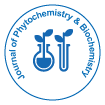Phytochemicals, Antioxidants and Antimicrobials Components in Leaf Extracts of Curcuma Caesia Roxb with Reference to Location
*Corresponding Author: Elseena Jose, Department of Pharmacy, Nirmala College of Pharmacy, Muvattupuzha, Kerala, India, Tel: 8147033292, Email: elseena_jose@yahoo.com
Citation: Jose E, George A, Mathew A, Neethu TR (2021) Phytochemicals, Antioxidants and Antimicrobials Components in Leaf Extracts of Curcuma Caesia Roxb with Reference to Location. J Phytochemistry Biochem 3: 114.
Copyright: © 2021 Jose E, et al. This is an open-access article distributed under the terms of the Creative Commons Attribution License, which permits unrestricted use, distribution, and reproduction in any medium, provided the original author and source are credited.
Abstract
Medicinal plants are reported to possess various activities. The present study was designed to compare the antimicrobial and antioxidant potency of Curcuma caesia Roxb, Himalayan variety, and native Kerala variety. Methanol extracts of both varieties of Curcuma caesia Roxb were investigated for the comparison of antimicrobial activity by the disk diffusion agar plate method. The activity index was calculated with was more than 0.5. Himalayan variety exhibited more antimicrobial activity towards gram-positive and the Indian variety exhibited more activity in the gram-negative microorganism. We also investigated the antioxidant activity of Curcuma caesia Roxb, Himalayan variety, and native Kerala variety by FRAP method. The maximum percentage of inhibition by the Himalayan variety was found to be 98.76 ± 0.2% and that of Indian variety was found to be 81.81 ± 0.32%. IC50 values were found to be 28.1 µg/ml, 29.9 µg/ml, and 39.9 µg/ml for ascorbic acid, Himalayan variety, and Indian variety respectively. The study has provided a basis to explore the chemical constituents in Curcuma caesia Roxb.

 Spanish
Spanish  Chinese
Chinese  Russian
Russian  German
German  French
French  Japanese
Japanese  Portuguese
Portuguese  Hindi
Hindi